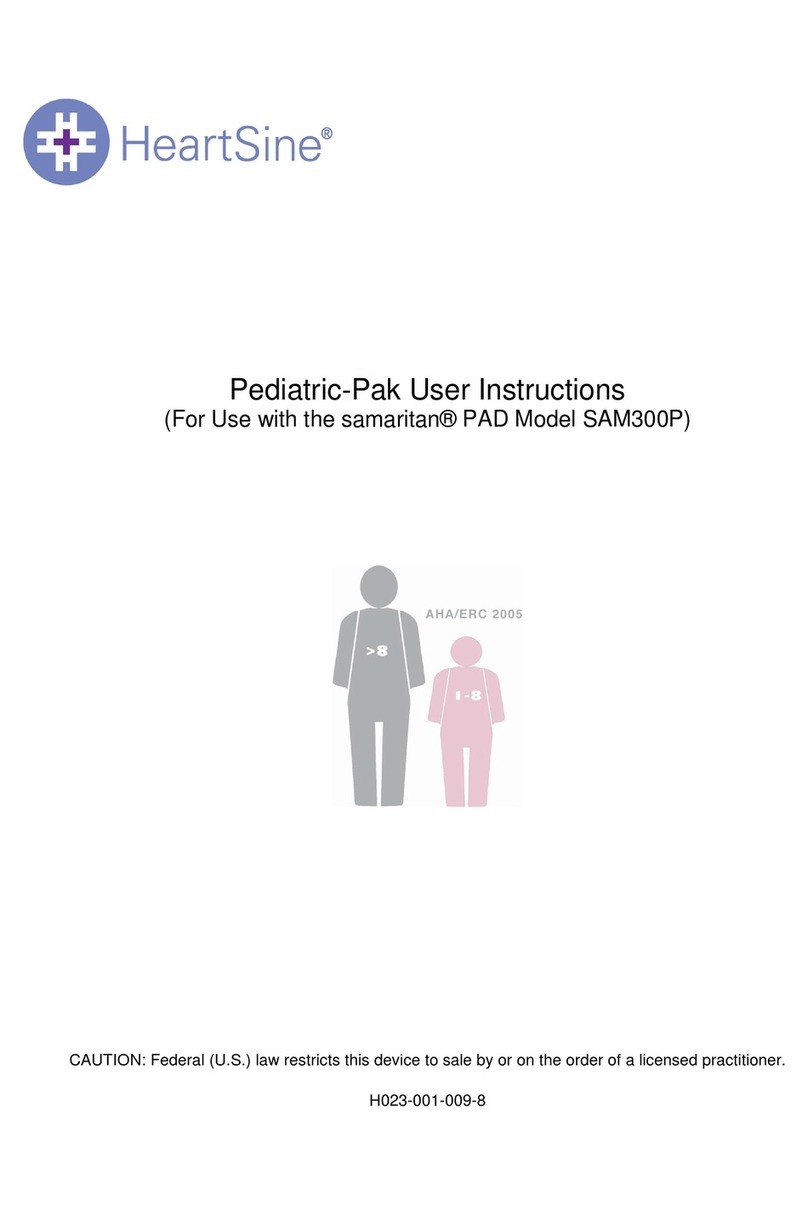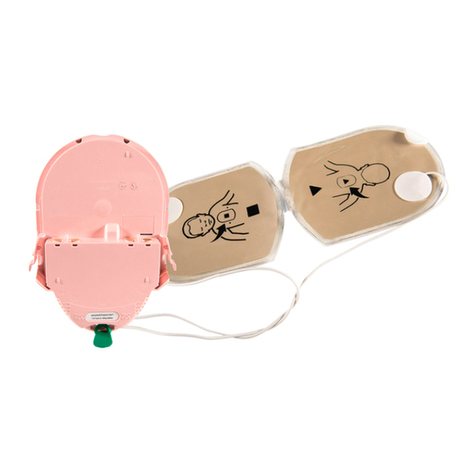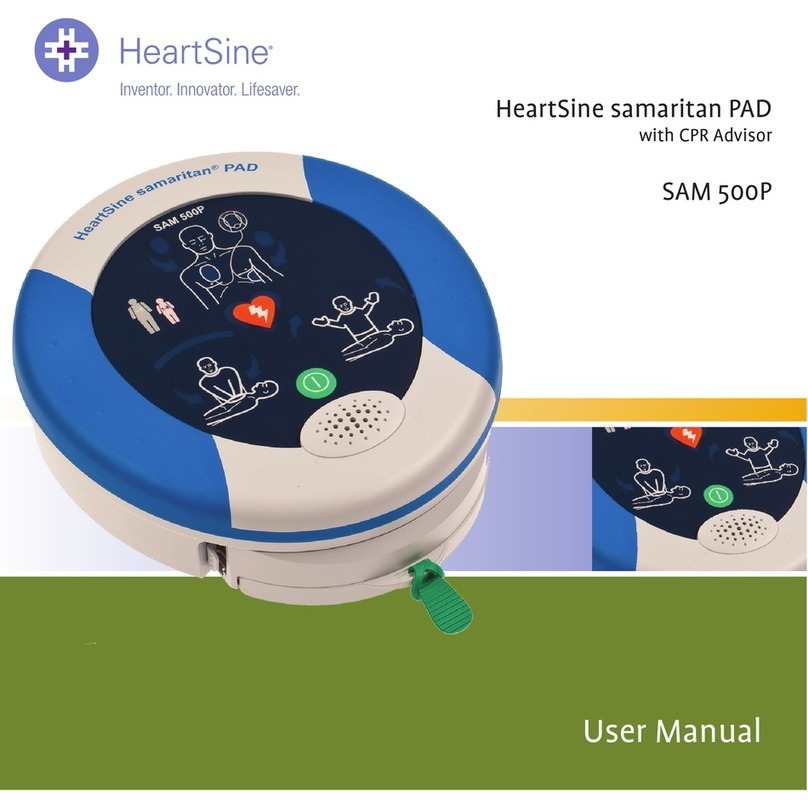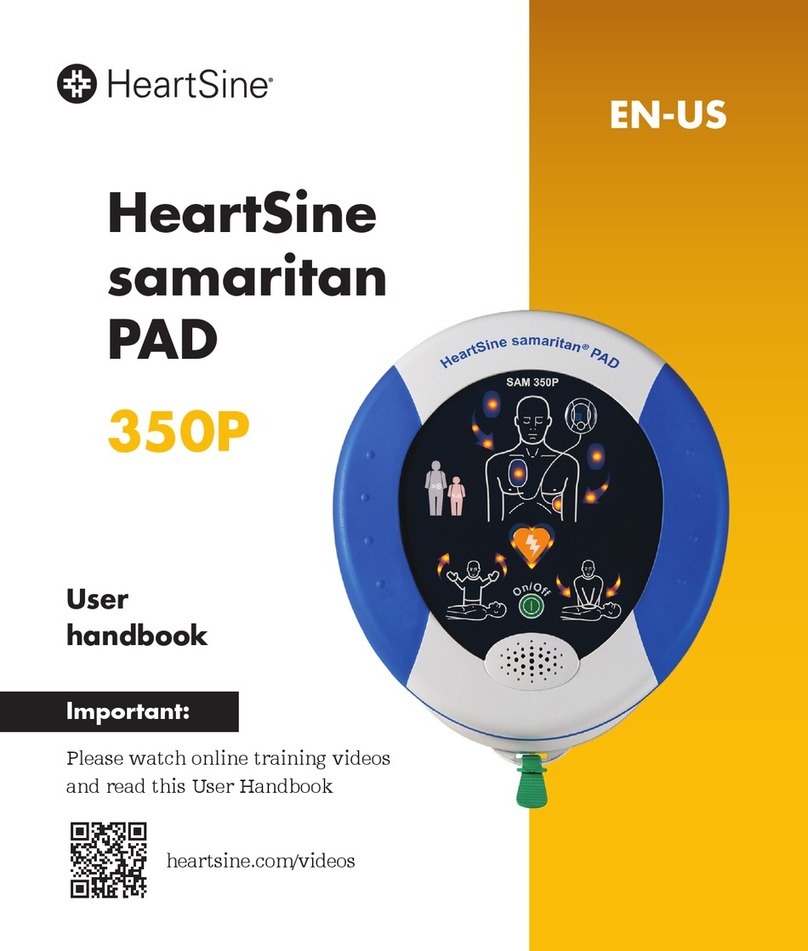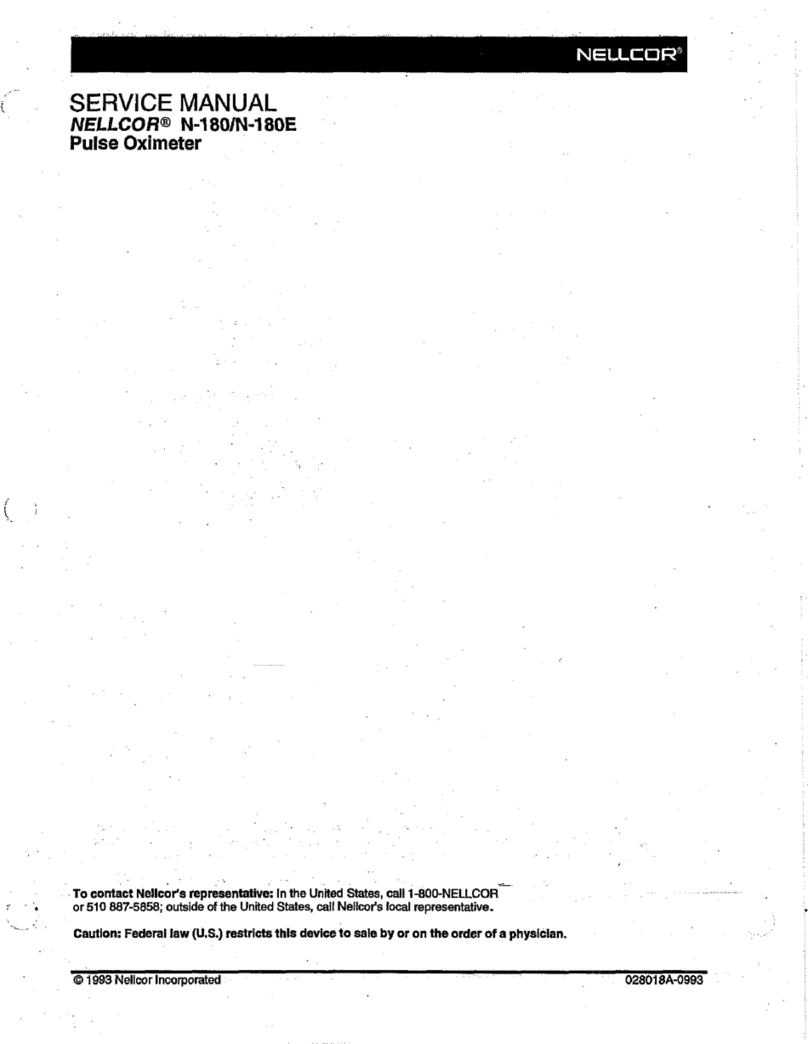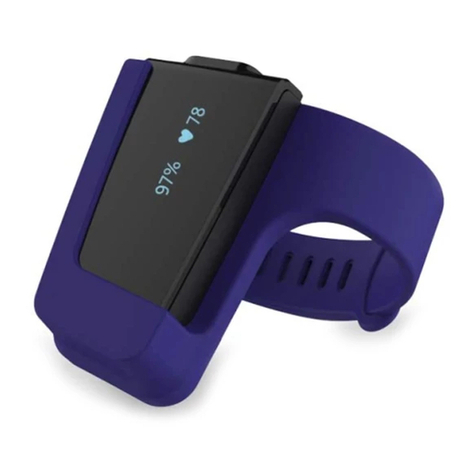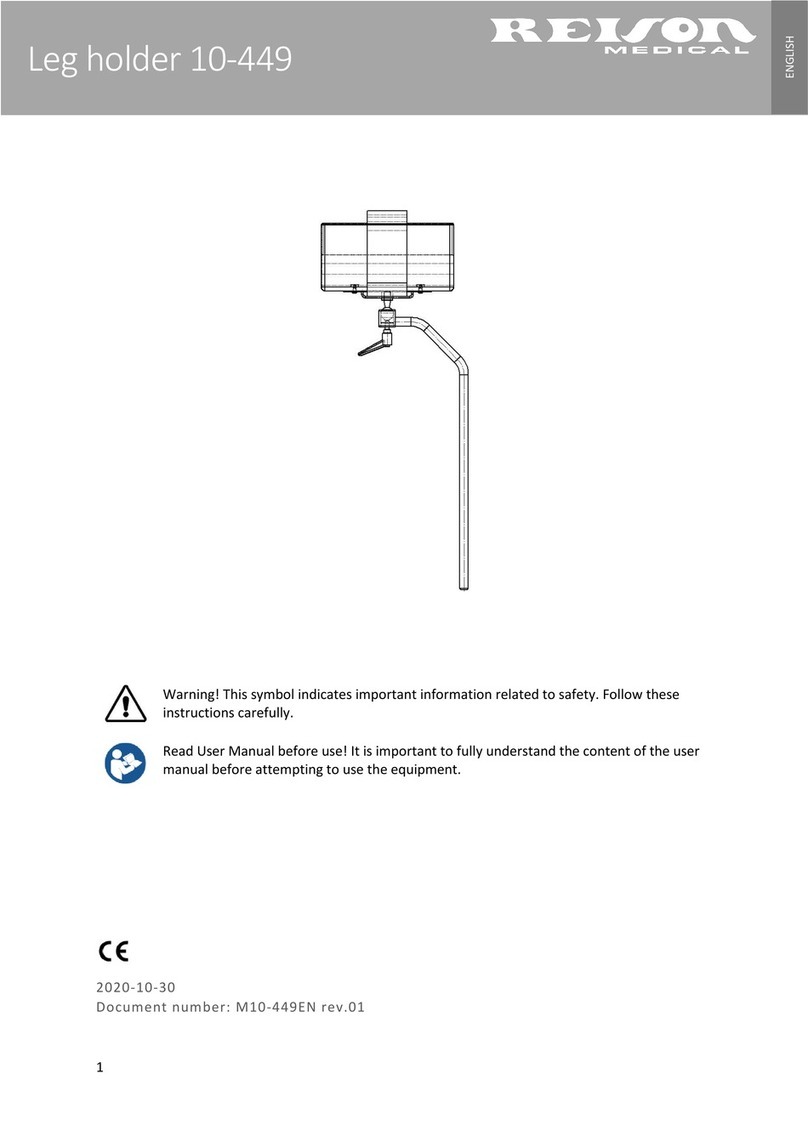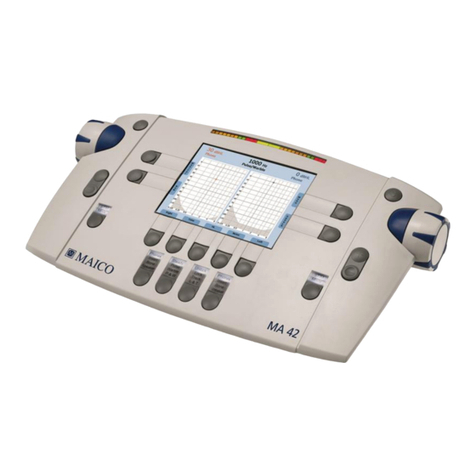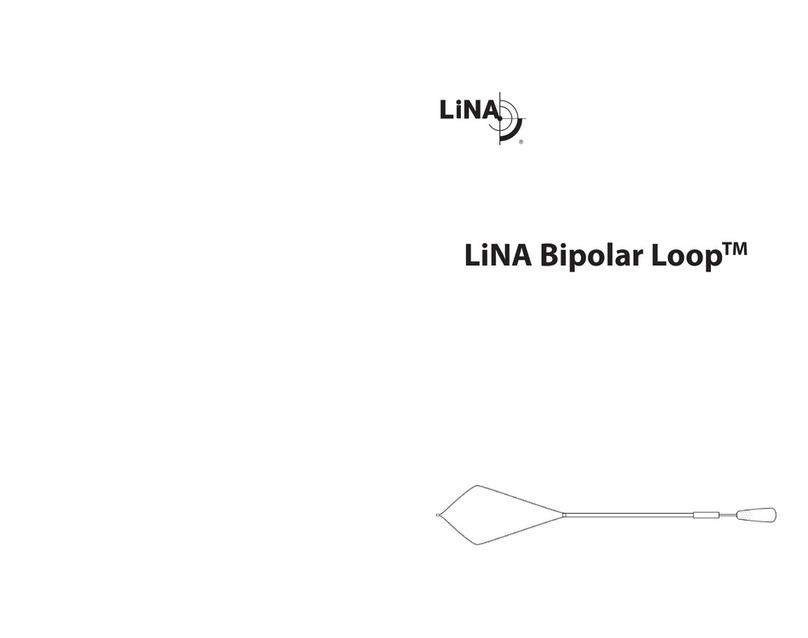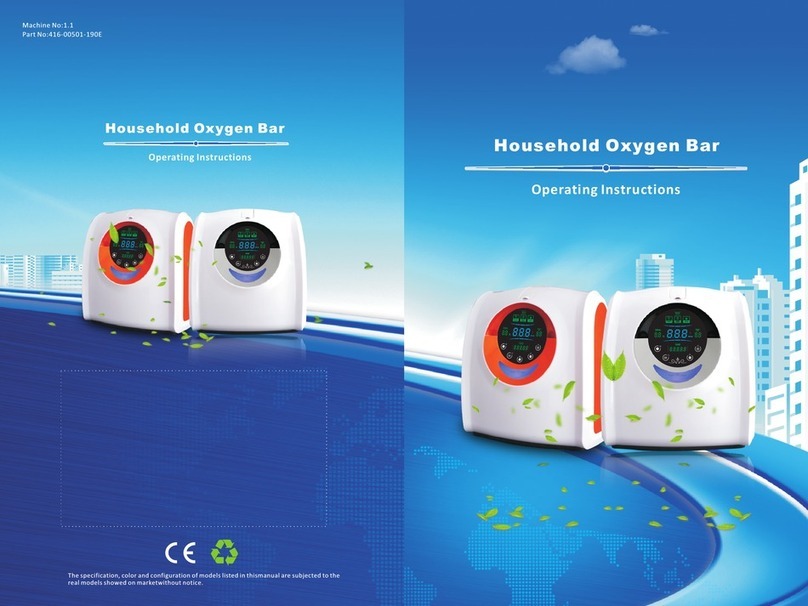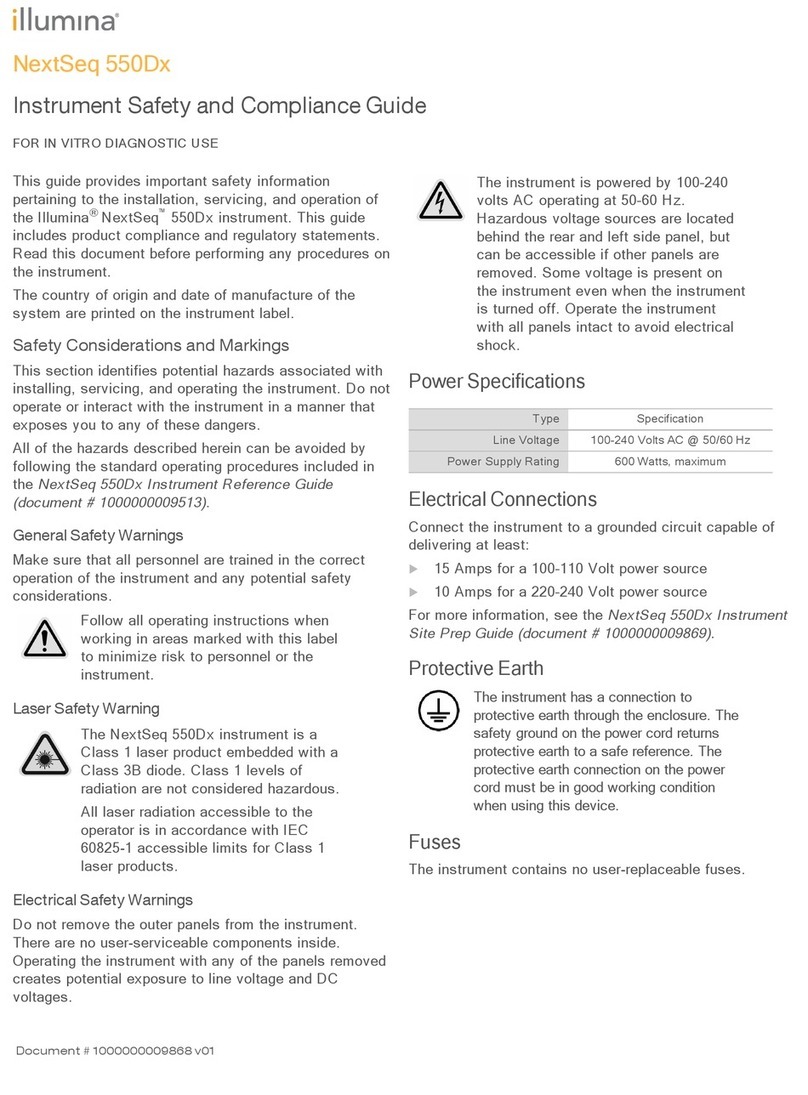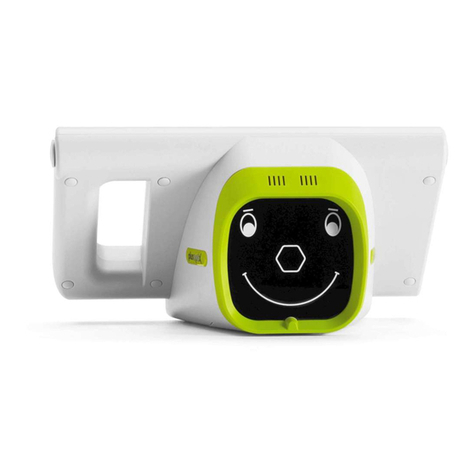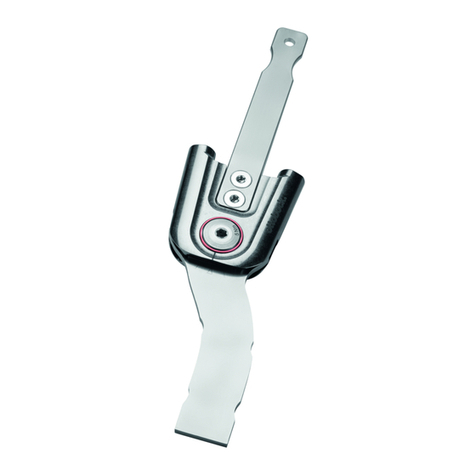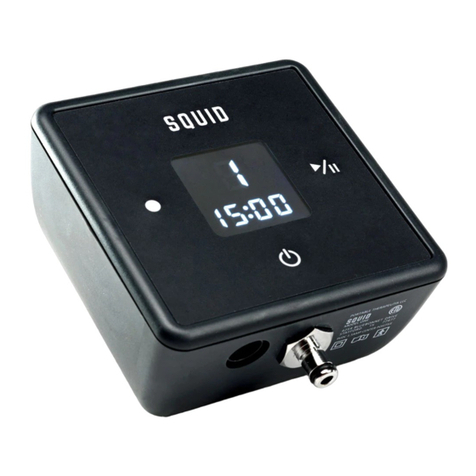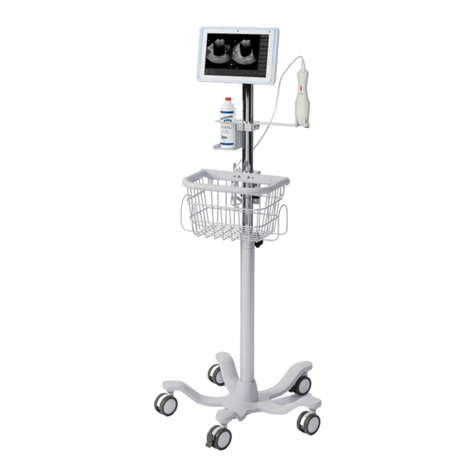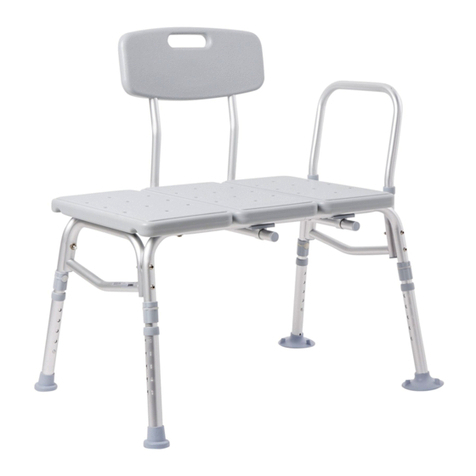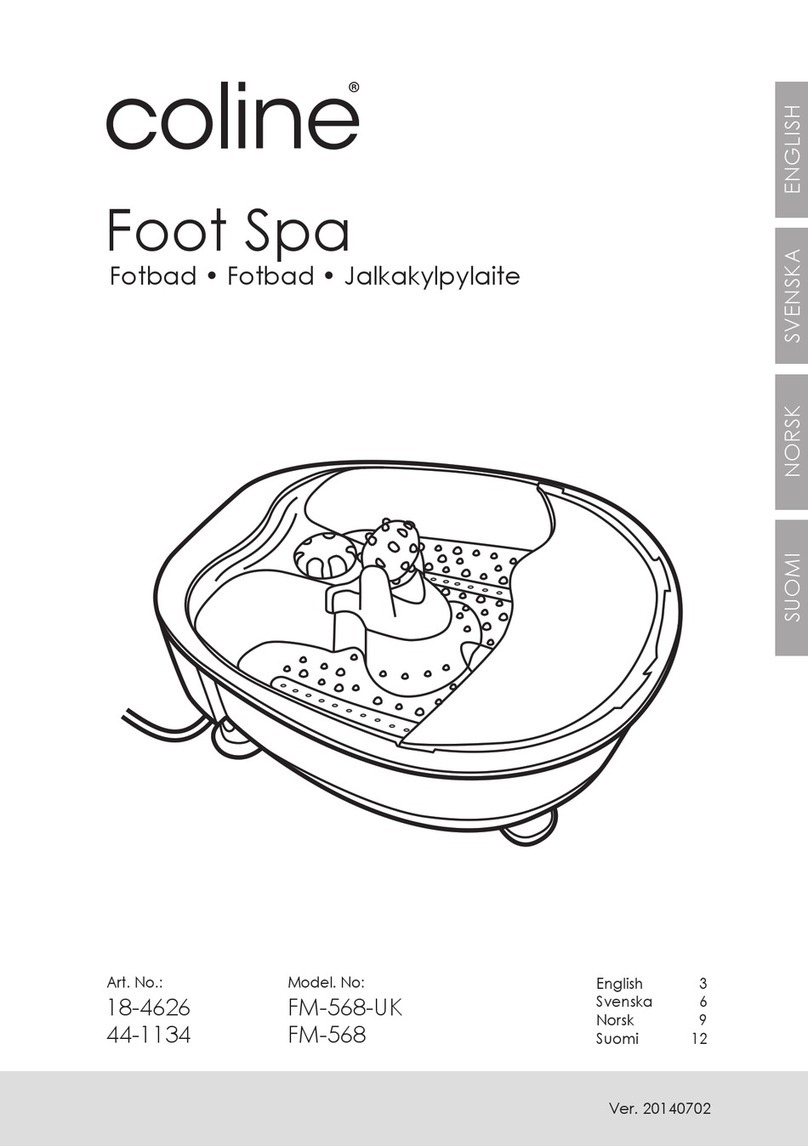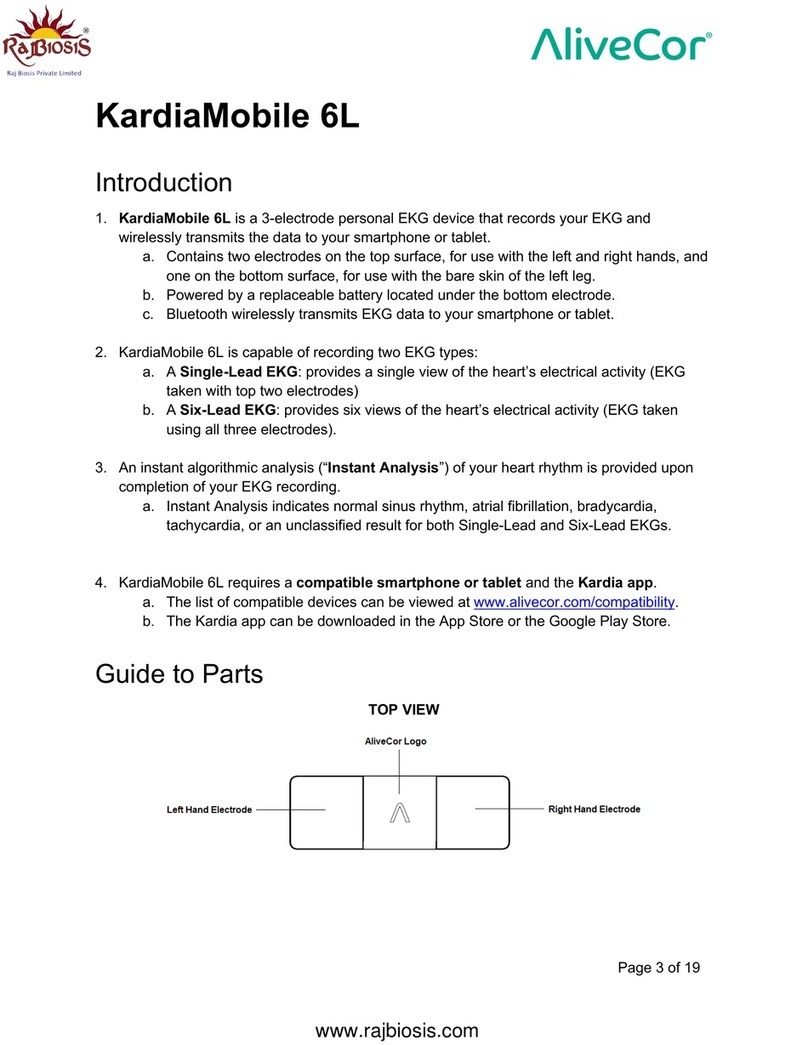HeartSine samaritan SAM 350P User manual

SAM 350P semi-automatic defibrillator
SAM 360P fully automatic defibrillator
SAM 450P semi-automatic defibrillator with CPR Rate Advisor
HeartSine®samaritan®
PAD
user manual
EN-US

2 EN-US
Table of contents
Indications for use 4
Contraindications for use 4
Caution 4
Warnings and cautions 5
Overview 8
Sudden cardiac arrest 8
Sinus rhythm and ventricular fibrillation 8
Ventricular tachycardia 8
Treatment by AED 8
Introduction 9
About the HeartSine samaritan PAD 9
CPR metronome 9
CPR Rate Advisor 10
Recommended training 10
Safety and effectiveness data 10
SAM 350P layout 11
SAM 360P layout 12
SAM 450P layout 13
Set-up 14
Unpacking 14
Pad-Pak 14
Putting the HeartSine samaritan PAD into service 15
Preparation checklist 16
Using the HeartSine samaritan PAD 17
Pad-Pak and Pediatric-Pak 22
Electrode placement 24
Adult 24
Pediatric 25
After using the HeartSine samaritan PAD 26
Cleaning the HeartSine samaritan PAD 26
Downloading and submitting event information 27
Disposal 27

User manual 3
EN-US
Tracking 28
Maintenance 29
Testing with simulators and manikins 29
APPENDICES 30
Appendix A Symbols A-1
Appendix B Troubleshooting B-1
Appendix C Technical data C-1
Appendix D Voice prompts D-1
Appendix E Safety and effectiveness data E-1
Appendix F Limited warranty statement F-1
Use of This Manual
It is important that you read this manual carefully before using your HeartSine
samaritan PAD. This manual is presented in support of any training you may
have received. If you have any questions, contact your Authorized Distributor or
HeartSine Technologies directly.
Caution
U.S. Federal law restricts this device to sale by or on the order of a physician.

4 EN-US
The HeartSine samaritan PAD SAM 350P (SAM 350P),
HeartSine samaritan PAD SAM 360P (SAM 360P) and
HeartSine samaritan PAD SAM 450P (SAM 450P)
all have the identical indications for use. Each is
indicated for use on victims of cardiac arrest who are
exhibiting the following signs:
• Unconscious
• Not breathing
• Without circulation (without a pulse)
The devices are intended for use by personnel who
have been trained in their operation. Users should
have received training in basic life support/AED,
advanced life support or a physician-authorized
emergency medical response training program.
The devices are indicated for use on patients greater
than 8 years old or over 55 lb (25 kg) when used with
the adult Pad-Pak (Pad-Pak-01 or Pad-Pak-07). They
are indicated for use on children between 1 and 8
years of age or up to 55 lb (25 kg) when used with the
Pediatric-Pak (Pad-Pak-02).
Contraindications for use
If the patient is responsive or conscious, do not use
the HeartSine samaritan PAD to provide treatment.
Caution
U.S. Federal law restricts this device to sale by or on
the order of a physician.
Indications for use

User manual 5
EN-US
WARNINGS
Patients suitable for treatment
The HeartSine samaritan PAD has been designed to
work on unconscious, nonresponsive patients. If the
patient is responsive or conscious, do not use the
HeartSine samaritan PAD to provide treatment.
The HeartSine samaritan PAD uses an interchangeable
battery and electrode pack called Pad-Pak. The
HeartSine samaritan PAD in combination with an
adult Pad-Pak is suitable for use on patients of over
55 lb (25 kg) in weight or equivalent to a child of
approximately 8 years old or over.
For use on smaller children (from 1 to 8 years old),
remove the adult Pad-Pak and install a Pediatric-
Pak. If a Pediatric-Pak or an alternative suitable
defibrillator is not available, you may use an adult
Pad-Pak.
If a pediatric patient is treated with an adult
Pad-Pak, ignore the CPR Rate Advisor feedback
prompts provided. The SAM 450P CPR Rate Advisor is
currently only intended to provide feedback on adult
patients.
Do not delay treatment
Do not delay treatment trying to find out the patient’s
exact age and weight.
Risk of electric shock
The HeartSine samaritan PAD delivers therapeutic
electrical shocks that can cause serious harm to either
users or bystanders. Take care to ensure that no one
touches the patient when a shock is to be delivered.
Do not open or repair
The HeartSine samaritan PAD has no serviceable
parts. Do NOT open or repair the device under any
circumstances as there could be danger of electric
shock. If damage is suspected, immediately replace
the HeartSine samaritan PAD.
Avoid explosive or flammable gases
The HeartSine samaritan PAD is safe to use with
oxygen mask delivery systems. However, to avoid the
risk of an explosion, it is strongly advised that you do
NOT use the HeartSine samaritan PAD in the vicinity
of explosive gases, including flammable anesthetics or
concentrated oxygen.
Do not touch the patient during analysis
Touching the patient during the analysis phase of
treatment can cause interference with the diagnostic
process. Avoid contact with the patient while the
HeartSine samaritan PAD is analyzing the patient. The
device will instruct you when it is safe to touch the
patient.
Fully automatic defibrillator (SAM 360P)
The SAM 360P is a fully automatic defibrillator.
When required, it will deliver a shock to the patient
WITHOUT user intervention.
Warnings and cautions

6 EN-US
Warnings and cautions
Use with other medical equipment
Disconnect non-defibrillation protected electronic
devices or medical equipment from the patient before
using the HeartSine samaritan PAD.
Use with pacemakers
The presence of a pacemaker should not affect the
functioning of the AED. However, to avoid damage to
the pacemaker, it is recommended that the pads are
placed at least 3.1 in (8 cm) away from a pacemaker. A
noticeable lump with a surgical scar should indicate
the location of an implanted device.1
CAUTIONS
Correct placement of electrode pads
Proper placement of the HeartSine samaritan PAD
electrode pads is critical. You must strictly observe the
instructions shown on pages 20-25 and on the device.
Wrong placement or the presence of air, hair, surgical
dressings or medicine patches between the pads and
the skin could reduce defibrillation effectiveness.
Slightly red skin after shock therapy is normal.
Do not use electrode pads if pouch is not
sealed
The Pad-Pak and Pediatric-Pak are single-use items
which must be replaced after each use or if the
pouch that seals the electrode pads has been broken
or compromised in any way. If you suspect that
the Pad-Pak or Pediatric-Pak is damaged, replace it
immediately.
CPR Rate Advisor function (SAM 450P)
The CPR Rate Advisor function is intended for use
on adult patients only. If a Pediatric-Pak is used, the
CPR Rate Advisor function is disabled. In this case,
the rescuer is prompted to begin CPR in time with
the metronome but receives no CPR Rate Advisor
feedback.
Susceptibility to electromagnetic
interference
Portable RF communications equipment (including
peripherals such as antenna cables and external
antennas) should not be used closer than 12 in (30 cm)
to any part of the HeartSine samaritan PAD including
cables specified by the manufacturer. Otherwise,
degradation of the performance of this equipment
could result.
Use of competitor or third-party products
DO NOT USE the HeartSine samaritan PAD,
Pad-Pak or Pediatric-Pak with any competitor or
third-party products. Use of electrical accessories,
transducers and cables other than those specified or
provided by HeartSine Technologies could result in
increased electromagnetic emissions or decreased
electromagnetic immunity of this equipment and
result in improper operation.
Use of the device
Use of this HeartSine samaritan PAD adjacent to or
stacked with other equipment should be avoided as
it could result in improper operation. If such use is
necessary, this HeartSine samaritan PAD and the
other equipment should be observed to verify that
they are operating normally.

User manual 7
EN-US
Correct disposal of the device
Dispose of the device in accordance with your national
or local regulations, or contact your Authorized
Distributor for assistance. Please follow the steps
provided in After using the HeartSine samaritan PAD
on page 27.
Compliance with local regulations
Check with the relevant local government health
department for information about any requirements
associated with ownership and use of a defibrillator in
the region where it is to be used.
The following symbols are used in this manual:
WARNING: Warning statements describe
conditions or actions that can result in death or
serious injury.
CAUTION: Caution statements describe
conditions or actions that can result in minor injury
or damage to the device.
NOTE: Notes contain important additional
information about using the defibrillator.
Temperature range for operation
The HeartSine samaritan PAD, with its battery and
electrodes, is designed to operate in the temperature
range of 32°F to 122°F (0°C to 50°C). Use of the
device outside of this range may cause the device to
malfunction.
Ingress protection
The HeartSine samaritan PAD has an IP56 rating
against dust and sprays of water. However, the IP56
rating does not cover the immersion of any part of
the HeartSine samaritan PAD in water or any type of
fluid. Contact with fluids may seriously damage the
device or cause fire or a shock hazard.
Prolonging battery life
Do not turn on the device unnecessarily as this may
reduce the standby life of the device. Standby storage
outside the range of 32°F to 122°F (0°C to 50°C) may
decrease the shelf-life of the Pad-Pak.
Operator training
The HeartSine samaritan PAD is intended for use by
personnel who have been trained in its operation.
Users should have received training in basic life
support/AED, advanced life support, or a physician-
authorized emergency medical response training
program.
Regular maintenance
Check the device periodically. See Maintenance on
page 29.

8 EN-US
Overview
of the heart, called the ventricles. Although there are
many different types of VT, this arrhythmia can be
potentially life-threatening if the patient presents
with no pulse and is unresponsive. If not treated
with immediate defibrillation VT may lead to other
arrhythmias.
Treatment by AED
It is a common misconception that CPR alone and
calling emergency services is enough. CPR is a
temporary measure that maintains blood flow and
oxygen to the brain. CPR alone will not return a
heart to a normal rhythm during VF or VT. The key to
survival is defibrillation – and the sooner the better.
Defibrillation is a common treatment for life-
threatening arrhythmias, mainly ventricular
fibrillation. Defibrillation consists of delivering an
electrical shock to the heart with a device called
a defibrillator. This restores normal heart muscle
contractions and allows normal sinus rhythm to be
restored by the body’s natural pacemaker in the heart.
The HeartSine samaritan PAD uses the HeartSine
samaritan ECG arrhythmia analysis algorithm. This
algorithm will evaluate the patient’s ECG to ascertain
if a therapeutic shock is appropriate. If a shock is
required, the HeartSine samaritan PAD will charge
and advise the user to press the shock button
(SAM 350P/450P) or will automatically deliver a shock
(SAM 360P). If no shock is advised, the device will
pause to allow the user to deliver CPR.
It is important to note that cardiac defibrillators, like
the HeartSine samaritan PAD, will not administer a
shock unless a lifesaving shock is required.
Sudden cardiac arrest
Sudden cardiac arrest (SCA) is a condition in which
the heart suddenly stops pumping blood effectively
due to a malfunction of the heart’s electrical system.
Often victims of SCA have no prior warning signs
or symptoms. SCA also can occur in people with
previously diagnosed heart conditions. Survival
from SCA depends on immediate and effective
cardiopulmonary resuscitation (CPR).
The use of an external defibrillator within the first
few minutes of a collapse can greatly improve a
patient’s chance of survival. Heart attack and SCA are
not the same, though sometimes a heart attack can
lead to an SCA. If you are experiencing symptoms of a
heart attack (chest pain, pressure, shortness of breath,
tight feeling in the chest or elsewhere in the body),
immediately seek medical attention.
Sinus rhythm and ventricular fibrillation
The normal heart rhythm, known as sinus rhythm,
creates electrical activity resulting in coordinated
contraction of the heart muscle. This generates
normal blood flow around the body.
Ventricular fibrillation (V-fib or VF) is a condition
in which there is uncoordinated contraction of the
heart muscle, making it quiver rather than contract
properly. Ventricular fibrillation is the most commonly
identified arrhythmia in SCA patients. In victims of
SCA it is possible to re-establish normal sinus rhythm
by means of an electric shock across the heart. This
treatment is called defibrillation.
Ventricular tachycardia
Ventricular tachycardia (VT) is a type of tachycardia
(rapid heartbeat) that arises from improper electrical
activity of the heart. VT starts in the bottom chambers

User manual 9
EN-US
The SAM 350P is a semi-automatic defibrillator, the
SAM 360P is a fully automatic defibrillator, and the
SAM 450P is a semi-automatic defibrillator with
integrated CPR Rate Advisor.
WARNING The SAM 360P is a fully
automatic defibrillator. When required, it will deliver
a shock to the patient WITHOUT user intervention.
CPR metronome
When the HeartSine samaritan PAD instructs you to
perform CPR, you will hear an audible beep and see
the safe to touch indicator flash at a rate compliant to
the latest AHA/ERC guidelines. This feature, referred
to as the CPR metronome, will guide you to the rate at
which to compress a patient’s chest during CPR.
This manual provides instructions for the following
models of the HeartSine samaritan PAD:
HeartSine samaritan PAD 350P (SAM 350P)
HeartSine samaritan PAD 360P (SAM 360P)
HeartSine samaritan PAD 450P (SAM 450P)
About the HeartSine samaritan PAD
The HeartSine samaritan PAD family of AEDs is
designed to quickly deliver a defibrillation shock to
victims of sudden cardiac arrest (SCA). Each HeartSine
samaritan PAD is designed to operate in accordance
with the current joint American Heart Association
(AHA) and European Resuscitation Council (ERC)
guidelines on Cardiopulmonary Resuscitation (CPR)
and Emergency Cardiovascular Care (ECC).
While all of the HeartSine samaritan PAD models
are very similar in use, there are distinct differences
between the models as shown in Table 1 below.
Introduction
Table 1. HeartSine samaritan PAD AEDs
Feature SAM 350P SAM 360P SAM 450P
Shock delivery Semi-automatic Fully automatic Semi-automatic
Four-year electrode and battery life 4 4 4
Audible and visual indicators 444
CPR coaching with metronome 4 4 4
CPR Rate Advisor 4
Pediatric use-compatible (with Pediatric Pad-Pak) 4 4 4

10 EN-US
Recommended training
SCA is a condition requiring immediate emergency
medical intervention. Due to the nature of the
condition, this intervention can be performed before
seeking the advice of a physician.
The HeartSine samaritan PAD is intended for use by
personnel who have been trained in its operation.
Users should have received training in basic life
support/AED, advanced life support, or a physician
authorized emergency medical response training
program. HeartSine Technologies also recommends
that this training be kept up to date by regular
refresher courses as and when recommended by your
training provider.
If potential users of the HeartSine samaritan PAD
are not trained in these techniques, contact your
Authorized Distributor or HeartSine Technologies
directly. Either can arrange for training to be
provided. Alternatively contact your local government
health department for information on certified
training organizations in your area.
Safety and effectiveness data
Please refer to Appendix E for the potential risks
associated with the use of an AED and a summary
of SAM 350P, SAM 360P and SAM 450P safety and
effectiveness data.
CPR Rate Advisor
When providing CPR treatment to a victim of sudden
cardiac arrest, it is vital the chest compressions are
of a good quality. If the quality of the CPR provided
is good, the chances of successfully resuscitating a
patient are greatly increased.
Research has demonstrated that non-professional
responders regularly provide ineffective CPR due to
inexperience.
The SAM 450P with CPR Rate Advisor provides
feedback to the rescuers on the rate of the CPR they
are providing to the victim. The SAM 450P uses
impedance cardiogram measurements to analyze
the speed of compressions and provide the user
with instruction to push faster or push slower or to
continue to provide compressions at a good speed
according to the AHA resuscitation guidelines. The
SAM 450P uses both audible and visual feedback to
give the responder instruction on CPR rate. Refer to
Technical data in Appendix C on page C-10.
WARNING The CPR Rate Advisor function is
intended for use on adult patients only. If a Pediatric-
Pak is used, the CPR function is disabled. In this case,
the rescuer is prompted to begin CPR in time with
the metronome but receives no CPR Rate Advisor
feedback.
Introduction

User manual 11
EN-US
SAM 350P layout
Status indicator
The SAM 350P is
ready for use when
this indicator is flashing
green.
Data port
Remove blue cover and
plug in the custom USB
data cable to download
event data from the
AED.
Attach pads icon/
action arrows
Attach the electrode
pads to the patient’s
bare chest as indicated
when the action arrows
are flashing.
Shock button
Press this button to
deliver a therapeutic
shock.
Do not touch icon/
action arrows
Do not touch the patient when
the action arrows above this icon
are flashing. The SAM 350P may
be analyzing the patient’s heart
rhythm or about to charge, in
preparation to deliver a shock.
On/Off button
Press this button
to turn on or turn
off the device.
Speaker
Listen for the
metronome and
verbal prompts.
Green tab
Pull this tab
to release the
electrodes.
Pad-Pak
Contains the
battery and
electrode pads.
Safe to touch icon/
action arrows
You may touch the
patient when the action
arrows around this icon
are flashing.
Adult and pediatric
symbols
Indicates that the SAM
350P is compatible with
both the Pad-Pak and
Pediatric-Pak.

12 EN-US
Introduction
Status indicator
The SAM 360P is
ready for use when
this indicator is
flashing green.
Data port
Remove blue cover and
plug in the custom USB
data cable to download
event data from the
AED.
Attach pads icon/
action arrows
Attach the electrode
pads to the patient’s
bare chest as indicated
when the action arrows
are flashing.
Shock icon
Flashes to indicate
a shock will be
delivered.
Do not touch icon/
action arrows
Do not touch the patient when
the action arrows above this
icon are flashing. The SAM 360P
may be analyzing the patient’s
heart rhythm or about to charge,
in preparation to deliver a shock.
On/Off button
Press this button
to turn on or turn
off the device.
Speaker
Listen for the
metronome and
verbal prompts.
Green tab
Pull this tab
to release the
electrodes.
Pad-Pak
Contains the
battery and
electrode pads.
Safe to touch icon/
action arrows
You may touch the
patient when the
action arrows around
this icon are flashing.
Adult and pediatric
symbols
Indicates that the SAM
360P is compatible with
both the Pad-Pak and
Pediatric-Pak.
SAM 360P layout

User manual 13
EN-US
SAM 450P layout
Status indicator
The SAM 450P is
ready for use when
this indicator is flashing
green.
Data port
Remove blue cover and plug in the
custom USB data cable to download
event data from the AED.
Attach pads icon/ action
arrows
Attach the electrode pads to
the patient’s bare chest as
indicated when the action
arrows are flashing.
Shock button
Press this button to
deliver a therapeutic
shock.
Safe to touch icon/action
arrows
You may touch the patient
when the action arrows around
this icon are flashing.
On/Off button
Press this button
to turn on or turn
off the device.
Speaker
Listen for the
metronome and
verbal prompts.
Green tab
Pull this tab
to release the
electrodes.
Pad-Pak
Contains the
battery and
electrode pads.
Do not touch icon/
action arrows
Do not touch the
patient when the
action arrows above
this icon are flashing.
The SAM 450P may
be analyzing the
patient’s heart rhythm
or about to charge, in
preparation to deliver
a shock.
Adult and pediatric
symbols
Indicates that the SAM
450P is compatible with
both the Pad-Pak and
Pediatric-Pak.
CPR Rate Advisor icon
Provides visual feedback
about the rate of chest
compressions during CPR.

14 EN-US
Figure 1. Adult Pad-Pak
Figure 2. Pediatric-Pak
Unpacking
Verify that the contents include the HeartSine
samaritan PAD, carry case, Pad-Pak, user manual and
warranty registration card.
Pad-Pak
A Pad-Pak is a single-use removable cartridge that
includes the battery and electrode pads in a single
unit. The Pad-Pak is available in two versions1:
1. Pad-Pak (gray color shown in Figure 1) for use on
patients weighing over 55 lb (25 kg), or equivalent
to a child of approximately 8 years of age or older.
2. The optional Pediatric-Pak (pink color shown in
Figure 2) for use on smaller children (from 1 to 8
years old and weighing under 55 lb (25 kg)).
WARNING Do not delay treatment trying to
determine the patient’s exact age and weight.
1The Pad-Pak also is available in a TSO/ETSO-certified
version for use on commercial fixed-wing aircraft.
Set-up

User manual 15
EN-US
Figure 4. Inserting a Pad-Pak
4. Verify that the green Status indicator (see the
layout for your model on pages 11-13) is blinking
to indicate the initial self-test routine has been
performed and the device is ready for use.
5. Press the On/Off button to turn on the
HeartSine samaritan PAD. Listen for, but do
not follow, the voice prompts to ensure that no
warning messages are played and that the device
prompts are in the expected language.
CAUTION Do NOT pull the green tab on
the Pad-Pak at this time. If you have pulled the tab
and opened the electrode drawer, you may need to
replace your Pad-Pak.
Only turn on the HeartSine samaritan PAD ONCE.
If you turn it on and off repeatedly, you will deplete
the batteries prematurely and may need to replace
the Pad-Pak.
Putting the HeartSine samaritan PAD
into service
Follow these steps to place your HeartSine samaritan
PAD into service:
1. Check the expiration date (YYYY-MM-DD) on the
rear of the Pad-Pak (see Figure 3). If the expiration
date has passed, do not use and immediately
replace the expired Pad-Pak.
PAD-PAK-01
YYYY/MM/DD
XXXXX
Figure 3. Expiration date
2. Unpack the Pad-Pak and retain the packaging in
case you need to return the Pad-Pak to HeartSine
Technologies.
3. Place the HeartSine samaritan PAD face up on
a flat surface and slide the Pad-Pak into the
HeartSine samaritan PAD (see Figure 4) until you
hear the “double click” to indicate that the tabs
on the right and left sides of the Pad-Pak are fully
engaged.

16 EN-US
Preparation checklist
Following is a checklist of the steps required to set up
your HeartSine samaritan PAD:
¨Step 1. Check the Pad-Pak expiration date.
¨Step 2. Install the Pad-Pak and check for a green
status indicator.
¨Step 3. Turn on the HeartSine samaritan PAD to
check operation.
¨Step 4. Turn off the HeartSine samaritan PAD.
¨Step 5. Store the HeartSine samaritan PAD in a
clean, dry environment at 32°F to 122°F (0°C to
50°C).
¨Step 6. Register your HeartSine samaritan PAD.
¨Step 7. Create a service schedule. (See
Maintenance on page 29.)
6. Press the On/Off button to turn off the
HeartSine samaritan PAD. Verify that the status
indicator is flashing green. If you have not heard
a warning message and the status indicator
continues to flash green, the device is ready
for use.
7. Place the HeartSine samaritan PAD in its supplied
soft carry case. Store the HeartSine samaritan
PAD where it will be seen and heard in an
unobstructed, secure location in a clean, dry
environment. Store the HeartSine samaritan PAD
out of reach of small children and pets. Be sure to
store the device according to the environmental
specifications (see Technical data in Appendix C on
page C-1).
CAUTION HeartSine Technologies
recommends that you store a spare Pad-Pak with
your HeartSine samaritan PAD in the rear section of
the soft carry case.
8. Register online, or complete the warranty
registration card and return it to your Authorized
Distributor or HeartSine Technologies directly (see
Tracking requirements on page 28).
9. Create a service schedule (see Maintenance on
page 29).
Set-up

User manual 17
EN-US
1
2
3
Using the HeartSine samaritan PAD
Follow these steps to use your AED, which will provide
you with step-by-step voice prompts. For a full list of voice
prompts for your device see Voice prompts in Appendix D.
CAUTION Once a non-shockable rhythm is detected,
the HeartSine samaritan PAD will end its ready to shock
condition if it had previously decided
to shock.
1. REMOVE DANGER
If necessary, move the patient to a safe location, or remove
any source of danger.
2. CHECK FOR A RESPONSE
If the patient is non-responsive, shake the patient by the
shoulders while speaking loudly. If the patient becomes
responsive, do not use the AED.
3. CHECK FOR AIRWAY
Check that the patient’s airway is not blocked, using a
head-chin tilt if necessary.
Using the HeartSine samaritan PAD

18 EN-US
4
6
7
4. CALL FOR MEDICAL ASSISTANCE
5. RETRIEVE THE AED
Ask others nearby to do so.
6. PERFORM CPR
While waiting for the AED, begin CPR, pushing hard and
fast at a rate of between 100 and 120 compressions per
minute (cpm) and a depth of 2 to 2.4 in (5 to 6 cm). If you
feel able to give rescue breaths perform 30 compressions
followed by two rescue breaths.
7. TURN ON THE AED
Press the On/Off button to turn on the AED.
8. DEFIBRILLATION THERAPY
Defibrillation therapy is tailored depending on whether
a Pad-Pak or Pediatric-Pak is installed. If the patient is
under 55 lb (25 kg) or 8 years of age, remove the Pad-Pak,
insert a Pediatric-Pak and press the On/Off button again
(see Pediatric-Pak on page 22). If a Pediatric-Pak is not
available, you may use the Pad-Pak.
Using the HeartSine samaritan PAD

User manual 19
EN-US
9
11
12
9. BARE THE CHEST AREA
Remove clothing from patient’s chest to expose bare skin,
removing any metal (bras or jewelry) where possible from
the pad placement area.
10. DRY THE PATIENT’S CHEST
Dry the patient’s chest if wet or clammy, and if a lot of
chest hair is present, shave the patient’s chest where the
electrodes will be placed.
11. PULL THE GREEN TAB
Pull the green tab to remove the electrode pad pouch from
the AED.
12. OPEN THE ELECTRODE POUCH
Tear open the pouch to remove the electrode pads.

20 EN-US
13
15
13. PLACE THE ELECTRODE PADS
Peel the liner from each electrode pad and apply each
electrode pad firmly to the patient’s bare chest. For a
patient over 8 years of age or weighing over 55 lb (25 kg),
place one electrode pad horizontally on the right chest, and
the other vertically on the left rib cage. For a patient under
8 years of age or weighing less than 55 lb (25 kg), you can
place one electrode pad on the center of the chest and the
other on the center of the back. Refer to pages 22-25 for
detailed instructions for electrode pad placement.
14. IF YOU AGAIN HEAR THE PROMPT
If you again hear the prompt to apply pads firmly to
patient’s bare chest, check that the:
• Pads are placed correctly as per pad placement shown.
• Pads are not touching and at least 1 inch (2.5 cm) apart.
• Entire surface of each pad is adhered to bare skin. If the
chest is hairy, shave the chest; if the chest is wet, dry
the chest.
• Ensure the Pad-Pak has not expired, and is correctly
inserted into the device.
15. DO NOT TOUCH THE PATIENT
When prompted, ensure that you are not touching the
patient.
Using the HeartSine samaritan PAD
Other manuals for samaritan SAM 350P
3
This manual suits for next models
2
Table of contents
Other HeartSine Medical Equipment manuals
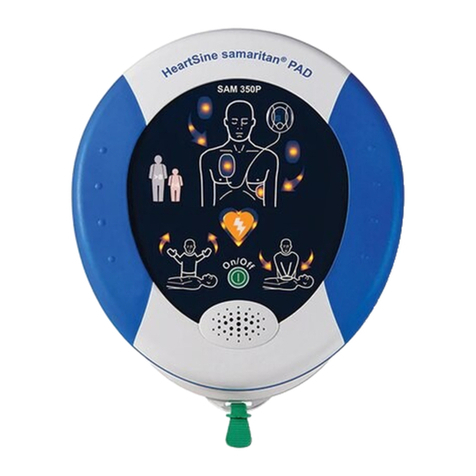
HeartSine
HeartSine samaritan SAM 350P User manual

HeartSine
HeartSine Samaritan PAD 300 User manual

HeartSine
HeartSine SAM 350P AED User manual
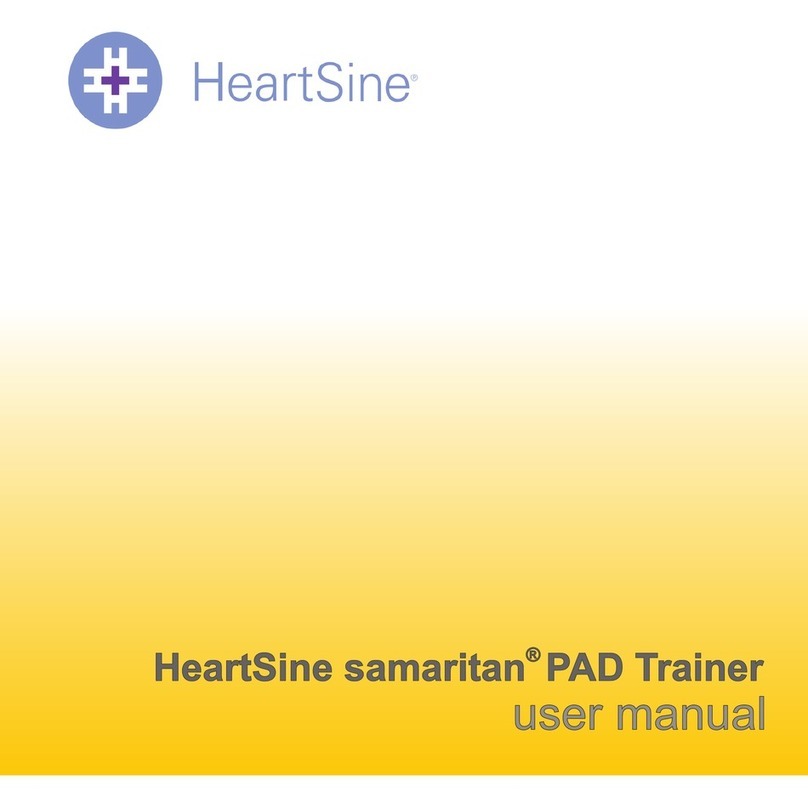
HeartSine
HeartSine samaritan User manual
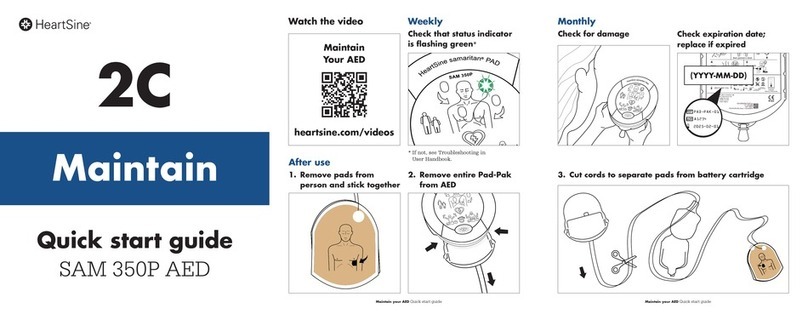
HeartSine
HeartSine SAM 350P AED User manual

HeartSine
HeartSine SAM 350P AED Manual

HeartSine
HeartSine samaritan PAD SAM 300P User manual
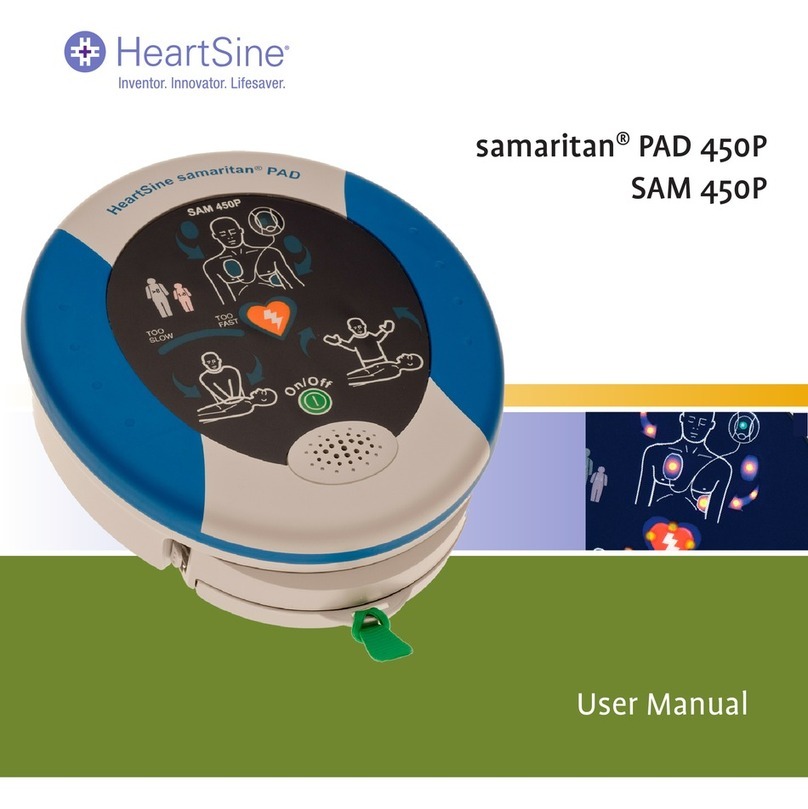
HeartSine
HeartSine samaritan PAD 450P User manual
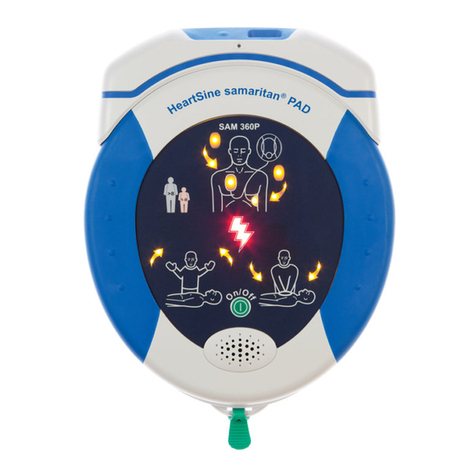
HeartSine
HeartSine samaritan PAD SAM 360P User manual

HeartSine
HeartSine samaritan PAD User manual
